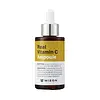What's inside
What's inside
 Key Ingredients
Key Ingredients

 Benefits
Benefits

 Concerns
Concerns

No concerns
 Ingredients Side-by-side
Ingredients Side-by-side

Hippophae Rhamnoides Water 78%
MaskingNiacinamide 5%
SmoothingButylene Glycol
HumectantMethylpropanediol
Solvent1,2-Hexanediol
Skin ConditioningBetaine
HumectantLaminaria Japonica Extract
Skin ProtectingEclipta Prostrata Leaf Extract
Skin ConditioningPiper Methysticum Leaf/Root/Stem Extract
Skin ConditioningPolyglyceryl-10 Stearate
Skin ConditioningPolyglyceryl-10 Oleate
Skin ConditioningCarbomer
Emulsion StabilisingEthylhexylglycerin
Skin ConditioningTromethamine
BufferingXanthan Gum
EmulsifyingAdenosine
Skin ConditioningFructooligosaccharides
HumectantHydrogenated Lecithin
EmulsifyingWater
Skin ConditioningBeta-Glucan
Skin ConditioningHippophae Rhamnoides Oil
EmollientPanthenol
Skin ConditioningSodium Hyaluronate
HumectantAllantoin
Skin ConditioningHydrolyzed Hyaluronic Acid
HumectantTranexamic Acid
Astringent3-O-Ethyl Ascorbic Acid
Skin ConditioningAscorbic Acid
AntioxidantPersea Gratissima Oil
Skin ConditioningTocopherol
AntioxidantAscorbic Acid Polypeptide
AntioxidantAscorbyl Glucoside
AntioxidantArbutin
AntioxidantBisabolol
MaskingPullulan
Hippophae Rhamnoides Water 78%, Niacinamide 5%, Butylene Glycol, Methylpropanediol, 1,2-Hexanediol, Betaine, Laminaria Japonica Extract, Eclipta Prostrata Leaf Extract, Piper Methysticum Leaf/Root/Stem Extract, Polyglyceryl-10 Stearate, Polyglyceryl-10 Oleate, Carbomer, Ethylhexylglycerin, Tromethamine, Xanthan Gum, Adenosine, Fructooligosaccharides, Hydrogenated Lecithin, Water, Beta-Glucan, Hippophae Rhamnoides Oil, Panthenol, Sodium Hyaluronate, Allantoin, Hydrolyzed Hyaluronic Acid, Tranexamic Acid, 3-O-Ethyl Ascorbic Acid, Ascorbic Acid, Persea Gratissima Oil, Tocopherol, Ascorbic Acid Polypeptide, Ascorbyl Glucoside, Arbutin, Bisabolol, Pullulan
 Reviews
Reviews

Alternatives
Ingredients Explained
These ingredients are found in both products.
Ingredients higher up in an ingredient list are typically present in a larger amount.
Adenosine is in every living organism. It is one of four components in nucleic acids that helps store our DNA.
Adenosine has many benefits when used. These benefits include hydrating the skin, smoothing skin, and reducing wrinkles. Once applied, adenosine increases collagen production. It also helps with improving firmness and tissue repair.
Studies have found adenosine may also help with wound healing.
In skincare products, Adenosine is usually derived from yeast.
Learn more about AdenosineArbutin is derived from the bearberry plant. It helps even out skin tone and reduce hyperpigmentation.
This ingredient has the ability to block tyrosinase, an enzyme that starts the process of skin darkening. When applied to the skin, arbutin works at a slow pace. This can make it less irritating than similar ingredients.
Kojic Acid is a similar ingredient.
Learn more about ArbutinAscorbic Acid is is pure Vitamin C. This form makes up the largest amount of vitamin C found naturally in our skin.
Not only is vitamin C great for your overall health and immune system, it also has plenty of benefits on your skin.
Vitamin C is best used for brightening skin. It improves dark spots, acne scars, and hyperpigmentation. This is because it blocks the process of skin darkening when exposed to UV.
Remember: Vitamin C should not replace sunscreen!
Your skin uses vitamin C to build collagen. Collagen is one key component in having a strong skin barrier and plump skin. Vitamin C also plays a role in regulating collagen, thus making it effective in improving wrinkles and fine lines.
Ascorbic acid shows potent antioxidant activity. As an antioxidant, it helps fight free-radicals. Free-radicals are molecules that may damage your skin cells. These antioxidants also protect skin against UV damage.
The best formulations include Vitamin E and/or ferulic acid. These two ingredients help stabilize and provide a boost in the benefits of ascorbic acid. This is because ascorbic acid becomes unstable when exposed to UV and air. In fact, you can tell your ascorbic acid has oxidized when it turns an orange-yellow color.
Ascorbic acid is generally compatible with other ingredients. However, using ascorbic acid with other active ingredients might cause irritation. Two ingredients: copper ions and benzoyl peroxide, will inactivate ascorbic acid completely.
Read more about other types of Vitamin C:
Foods rich with vitamin C include oranges, strawberries, broccoli, bell peppers, and more. When consuming Vitamin C, your skin receives a portion of the nutrients.
Learn more about Ascorbic Acid